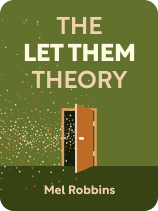

This article is an excerpt from the Shortform book guide to "The Let Them Theory" by Mel Robbins. Shortform has the world's best summaries and analyses of books you should be reading.
Like this article? Sign up for a free trial here.
What is the boomerang effect in psychology? Why do people do the opposite of what you want them to do?
The boomerang effect is when you push for something to happen, only for the opposite to take place. Mel Robbins describes something similar to the boomerang effect in her book, The Let Them Theory, in discussing the need for a supportive environment to encourage changes in people.
Let’s look at the boomerang effect in action.
Stop Pressuring Other People to Change
What is the boomerang effect? If you’ve ever tried to push somebody else to change, then you know it almost never works. This is where the boomerang effect takes place. Attempting to persuade or change a person often means they’ll do the exact opposite because they feel their freedom is being restricted. To avoid this effect, you have to create an environment of acceptance and love to enable people to make changes in their own time. We all have a fundamental need for autonomy and control over our lives, and we naturally resist attempts by others to force change because these attempts threaten this core need. However, when we feel fully accepted and loved unconditionally, we’re free to look inward and find our own motivation to grow.
Robbins recommends several steps to create this supportive environment: Practice radical acceptance of others without judgment, express unconditional love while separating who they are from behaviors you dislike, be patient as change happens naturally, celebrate positive steps, and provide resources only when asked. By modeling the positive changes you’d like to see rather than criticizing or controlling, you allow them space to decide for themselves that they want to change. The goal isn’t to enable self-destructive behavior but to provide the emotional safety that makes meaningful change possible. Paradoxically, when people feel truly accepted as they are, they become more willing and able to transform themselves.
(Shortform note: In Love Undetectable, Andrew Sullivan explores the contrasting dynamics of control in different types of relationships. While romantic relationships often involve surrendering control to another person—making ourselves vulnerable by placing our emotional well-being partially in their hands—friendships are different. Where romance might tempt us to merge identities or influence our partner’s choices, friendship thrives specifically because we respect the other person’s autonomy and separate life path. Both Sullivan and Robbins recognize that true connection emerges not from managing others’ behaviors, but from creating space where both people can exercise their freedom while choosing to remain in each other’s lives.)
| The Boomerang Effect: Why Pushing for Change Also Pushes People Away Robbins’s advice to stop pressuring others to change is supported by psychological research in a phenomenon known as “the boomerang effect.” When we try to force someone to change, they often respond by doubling down on their original behavior—like a boomerang that flies in the opposite direction of your throw before circling back to hit you in the face. This resistance to persuasion is deeply rooted in our psychological need for autonomy. Social psychologists have documented countless examples: putting up stern signs saying “Do not write on this wall” actually increases graffiti compared to gentler requests. Similarly, when Romeo and Juliet, the protagonists of one of Shakespeare’s most beloved plays, were forbidden to be together, their love intensified rather than diminished. (Hence social psychologists’ nickname for this phenomenon: “the Romeo and Juliet effect.”) The boomerang effect explains why your well-intentioned efforts to get your partner to exercise, convince your friend to quit smoking, or push your sibling to change careers often backfire. The moment someone feels their freedom of choice is threatened, they instinctively resist to regain control. Robbins’s approach of creating an environment of acceptance circumvents this psychological trap. By removing pressure and judgment, you eliminate the trigger for defensive resistance. This doesn’t mean enabling harmful behavior—it means recognizing that sustainable change can only come from within. By practicing radical acceptance, you’re not abandoning your hope for change: You’re actually creating the psychological safety that makes change possible. The person who feels completely accepted paradoxically becomes free to consider changing, without the defensive barriers that pressure creates. |

———End of Preview———
Like what you just read? Read the rest of the world's best book summary and analysis of Mel Robbins's "The Let Them Theory" at Shortform.
Here's what you'll find in our full The Let Them Theory summary:
- A simple but powerful framework for reclaiming your time and mental energy
- How to detach from situations and behaviors that are outside your influence
- How the "let them" theory can be taken too far, and how to avoid it from happening






